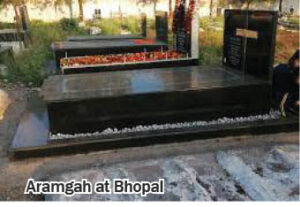83-year-old Gev M. Dhunjibhoy, a permanent resident of Bhopal City since September, 1961, is one of the senior-most members of the Bhopal Parsi Panchayat. He shares how the city of Bhopal got its first and only Parsi Aramgah. (Courtesy: Col. Firoze B. Allavali, President – Bhopal Parsi Anjuman)
 1At the time of my coming to the wonderful city of Bhopal as an employee of BHEL (Bharat Heavy Electricals Limited), there were many Parsi families living here. Some of them were in prominent positions, like K F Rustomji – IGP, who then became Director Border Security Force; Sam Bharucha, Mr. Marfatia – the cotton mill head, Mr. Divetri – Regional General Manager of Central Bank and Mr. Mina Sanjana – Chief Personnel Manager, BHEL, etc.
1At the time of my coming to the wonderful city of Bhopal as an employee of BHEL (Bharat Heavy Electricals Limited), there were many Parsi families living here. Some of them were in prominent positions, like K F Rustomji – IGP, who then became Director Border Security Force; Sam Bharucha, Mr. Marfatia – the cotton mill head, Mr. Divetri – Regional General Manager of Central Bank and Mr. Mina Sanjana – Chief Personnel Manager, BHEL, etc.
Being a member of Parsi community, I had the opportunity to meet all of them frequently and by way of mutual discussion, I came to understand the history of Bhopal’s Parsi Aaramgah, which I’d like to share with you.
It was the year 1914, on the day of August 17th, a rail accident occurred near Bhopal, in which many people died, including a Parsi gentleman by the name of Pestonji Dadabhai Shikari. Since there was no Parsi graveyard or burial facility in Bhopal at that point in time, the wife of late Pestonji Shikari decided to buy and donate a piece of land to be used as a Parsi graveyard in Bhopal.
This land was donated with the pre-condition, that the first grave on entrance will be of late Pestoni Dadabhai Shikari and any burial be done in future should only be beyond his grave. The condition is followed till date. This is how the city of Bhopal got its first and only Parsi Aramgah.
- દિકરી એટલે બીજી માં… - 20 April2024
- નાગપુરની બાઈ હીરાબાઈ એમ. મુલાનદરેમહેરનો ઇતિહાસ - 20 April2024
- વિશ્વ ભારતી સંસ્થાન દ્વારા રતિ વાડિયાનુંસન્માન કરવામાં આવ્યું - 20 April2024
